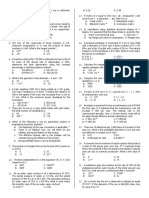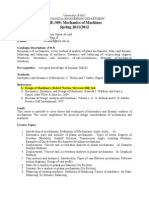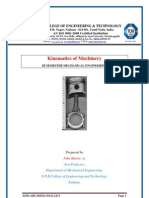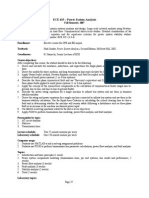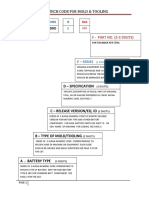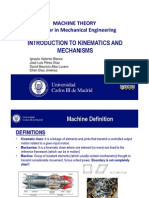0 ratings0% found this document useful (0 votes)
78 viewsKine Lec
Kine Lec
Uploaded by
Dhenil ManubatThis document outlines the course details for a Kinematics of Machinery lecture. The course will meet for 3 hours online per week on Tuesdays and Wednesdays. The course description explains that topics will include planar and spatial linkages, cams, gears, and robotic manipulators. The course outcomes are to apply kinematics concepts, understand mechanism principles and analysis methods. The course outline lists specific topics like mechanisms, kinematics, belts, gears, cams and their analysis. Potential references are provided and the grading system breaks down assessments into exams, quizzes, assignments, and attendance.
Copyright:
© All Rights Reserved
Available Formats
Download as DOCX, PDF, TXT or read online from Scribd
Kine Lec
Kine Lec
Uploaded by
Dhenil Manubat0 ratings0% found this document useful (0 votes)
78 views2 pagesThis document outlines the course details for a Kinematics of Machinery lecture. The course will meet for 3 hours online per week on Tuesdays and Wednesdays. The course description explains that topics will include planar and spatial linkages, cams, gears, and robotic manipulators. The course outcomes are to apply kinematics concepts, understand mechanism principles and analysis methods. The course outline lists specific topics like mechanisms, kinematics, belts, gears, cams and their analysis. Potential references are provided and the grading system breaks down assessments into exams, quizzes, assignments, and attendance.
Original Description:
sgdfgfgd
Original Title
kine lec
Copyright
© © All Rights Reserved
Available Formats
DOCX, PDF, TXT or read online from Scribd
Share this document
Did you find this document useful?
Is this content inappropriate?
This document outlines the course details for a Kinematics of Machinery lecture. The course will meet for 3 hours online per week on Tuesdays and Wednesdays. The course description explains that topics will include planar and spatial linkages, cams, gears, and robotic manipulators. The course outcomes are to apply kinematics concepts, understand mechanism principles and analysis methods. The course outline lists specific topics like mechanisms, kinematics, belts, gears, cams and their analysis. Potential references are provided and the grading system breaks down assessments into exams, quizzes, assignments, and attendance.
Copyright:
© All Rights Reserved
Available Formats
Download as DOCX, PDF, TXT or read online from Scribd
Download as docx, pdf, or txt
0 ratings0% found this document useful (0 votes)
78 views2 pagesKine Lec
Kine Lec
Uploaded by
Dhenil ManubatThis document outlines the course details for a Kinematics of Machinery lecture. The course will meet for 3 hours online per week on Tuesdays and Wednesdays. The course description explains that topics will include planar and spatial linkages, cams, gears, and robotic manipulators. The course outcomes are to apply kinematics concepts, understand mechanism principles and analysis methods. The course outline lists specific topics like mechanisms, kinematics, belts, gears, cams and their analysis. Potential references are provided and the grading system breaks down assessments into exams, quizzes, assignments, and attendance.
Copyright:
© All Rights Reserved
Available Formats
Download as DOCX, PDF, TXT or read online from Scribd
Download as docx, pdf, or txt
You are on page 1of 2
COURSE OUTLINE/SYLLABUS
KINEMATICS OF MACHINERY LECTURE
SUBJECT CODE: MT8-M
3 HOURS ONLINE CLASS/WEEK
CLASS SCHEDULE: BET-MT 3B/3E (TUESDAY 4:00PM – 6:00PM)
BET-MT 3A/3D (WEDNESDAY 8:00AM – 10:00AM)
BET-MT 3C/3F (WEDNESDAY 11:00AM – 1:00PM)
Course Description: Design, selection, and evaluation of mechanisms for various applications. Topics
include planar and spatial linkages, cams, gears, planetary and non-planetary gear systems, linkage
synthesis, linkage dynamics, and an introduction to robotic manipulators using vector, matrix, and
complex number methods. Plates involve analysis and plotting of motion and inertial forces in planar and
spatial linkages.
Course Outcomes: After completing this course subject, the student must be able to:
1. Apply concepts of Kinematics of Machines and mechanism to their future field of work.
2. Understand the working principle of mechanism to machines or assembly of system.
3. Understand the fundamental concepts and laws of mechanics including equilibrium and newtons
law of motion.
4. Understand the analysis of velocity and acceleration by graphical and analytical method.
5. Gain knowledge and information about the mechanical transmitting devices, cam and follower
profile and gear profiles.
Course Outline:
1. Mechanism & Machines
- Terminology and Definitions, Mechanism & Machines. rigid and resistance body, link,
Kinematic pair Types of motion, degrees of freedom, classification of Kinematic pairs,
Kinematic Chain, Linkage, Mechanics, Kinematic Inversion of Single and Double slider
crank Chain, Four bar Chain Mechanism with lower pairs, Straight line, Quick return
mechanisms, Steering gear mechanisms such as Davis and Ackermann Steering gear.
2. Kinematics
- Displacement, velocity and acceleration and analysis in simple mechanisms, Graphical
Method velocity and acceleration polygons, Instantaneous Centre of Velocity, Kennedy
Theorem, Angular velocity ratio theorem, Kinematic analysis by Algebraic methods, Vector
Approach, Acceleration analysis, Klein’s Construction, Coriolis Acceleration. Kinematic
Analysis of Mechanism like Slider Crank Mechanism, Four-Bar Mechanism
3. Belt, Ropes & Chains
4. Rolling Bodies in pure Contact
5. Cam Design
6. Gears
Potential References:
1. Doughtie, V. L., & James, W. H. (1954). Elements of Mechanism. New York: John Wiley & Sons
2. Peter Schwamb, S.B., & Allyne L. Merrill, S.B. (1904) Elements of Mechanisms. New York:
John Wiley & Sons.
3. NPTEL (National Programme on Technology Enhanced Learning): Kinematics of Machines
GRADING SYSTEM:
MAJOR EXAM -------------------------------------------------------- 45%
Preliminary Examination (15%)
Midterm Examination (15%)
Final Examination (15%)
QUIZZES/SEATWORK ---------------------------------------------- 15%
HOME ACTIVITY/RESEARCH PAPER -------------------------- 20%
ONLINE RECITATION ---------------------------------------------- 10%
ATTENDANCE -------------------------------------------------------- 10%
100%
NOTE:
For Computation of grades for Major Examination:
- Average Score, Save : Save=ΣS /n
Where: ΣS− of all accumulated scores ¿ prelim ¿ final exam .
∑
n−Total no . of points of prelim ¿ final examination .
- Equivalent Grade, G:
G = Save/2 + 50%
- Accumulated Grade, AG:
AG = G X 45%
You might also like
- ROBOTICS by Appin Knowledge (Download Tai Tailieutuoi - Com)Document10 pagesROBOTICS by Appin Knowledge (Download Tai Tailieutuoi - Com)Kevin Raymundo Padilla RodriguezNo ratings yet
- Theory of Machines Interview Questions and AnswersDocument11 pagesTheory of Machines Interview Questions and Answerskumarmohit0203100% (1)
- Machine Learning for Time Series Forecasting with PythonFrom EverandMachine Learning for Time Series Forecasting with PythonRating: 4 out of 5 stars4/5 (2)
- HQ9000 7000 Service Manual PDFDocument459 pagesHQ9000 7000 Service Manual PDFPhụng Minh Nguyễn63% (8)
- Tensile Test Experiment ME 3228: Materials and Mechanics Lab Section: 519Document23 pagesTensile Test Experiment ME 3228: Materials and Mechanics Lab Section: 519Dhenil ManubatNo ratings yet
- Sample 03 Rev 1Document5 pagesSample 03 Rev 1Dhenil ManubatNo ratings yet
- Robotic End Effector NotesDocument24 pagesRobotic End Effector NotesTibebu MerideNo ratings yet
- Course Outline Mechanics Machines ME3033Document4 pagesCourse Outline Mechanics Machines ME3033Mohammad Faraz AkhterNo ratings yet
- 6th Sem Syllabus MechanicalDocument9 pages6th Sem Syllabus Mechanicalshivanikumari851216No ratings yet
- Gujarat Technological University Automobile Engineering (02) /mechanical EngineeringDocument2 pagesGujarat Technological University Automobile Engineering (02) /mechanical EngineeringrupalvyasaNo ratings yet
- 6 Sem SyllabusDocument7 pages6 Sem SyllabusAjinkya NawghareNo ratings yet
- Kom Lecture NotesDocument163 pagesKom Lecture NotesgvnagamaniNo ratings yet
- Bmee207l Kinematics-And-dynamics-Of-machines TH 1.0 67 Bmee207lDocument3 pagesBmee207l Kinematics-And-dynamics-Of-machines TH 1.0 67 Bmee207lShatakshi UjjainNo ratings yet
- KOM Final 13 May 2020Document5 pagesKOM Final 13 May 2020Nilesh GhugeNo ratings yet
- ME-309: Mechanics of Machines Spring 2011/2012: Instructor: Office: E-Mail: Catalogue Description: (3-0-3)Document14 pagesME-309: Mechanics of Machines Spring 2011/2012: Instructor: Office: E-Mail: Catalogue Description: (3-0-3)Diala DurubiNo ratings yet
- Course OutlineDocument3 pagesCourse OutlineHaile SimachewNo ratings yet
- BTech Auto SyllDocument30 pagesBTech Auto SyllAjayChouhanNo ratings yet
- Kom CoursefileDocument53 pagesKom CoursefileManda Ramesh BabuNo ratings yet
- Course Outline PDFDocument5 pagesCourse Outline PDFbukhariNo ratings yet
- Kinematics of Machines III Sem Syllabus 01092021Document4 pagesKinematics of Machines III Sem Syllabus 01092021Milind KshirsagarNo ratings yet
- Kinematics of Machinery: II B.Tech IV SemesterDocument2 pagesKinematics of Machinery: II B.Tech IV SemesterPraveen KumarNo ratings yet
- Kom II-II r15 SyllabusDocument3 pagesKom II-II r15 SyllabusSree MurthyNo ratings yet
- KMDocument120 pagesKMsankara25101991No ratings yet
- ME6401 SCAD MSM by EasyEngineering - Net 1Document122 pagesME6401 SCAD MSM by EasyEngineering - Net 1shankar0% (1)
- Kinematics of Machinery: Lecture NotesDocument3 pagesKinematics of Machinery: Lecture NotesPraveen KumarNo ratings yet
- Me Automation & Robotics SyllabusDocument27 pagesMe Automation & Robotics SyllabusweenniiNo ratings yet
- TE Syllabus Mech PDFDocument40 pagesTE Syllabus Mech PDFSanket JadhavNo ratings yet
- Syllabus (New2013 Pattern) - TOM-IDocument14 pagesSyllabus (New2013 Pattern) - TOM-IAkshayNo ratings yet
- Mechanical Engineering 2006 Sem VDocument8 pagesMechanical Engineering 2006 Sem VMansanth BoseNo ratings yet
- Me6401 KomDocument128 pagesMe6401 KomThomas LafontaineNo ratings yet
- Mech Sylabus 21Document1 pageMech Sylabus 21Honey SinghNo ratings yet
- ME301 Mechanics of MachineryDocument2 pagesME301 Mechanics of MachineryVishnu Mohan M SNo ratings yet
- M.Tech. - Industrial ElectronicsDocument6 pagesM.Tech. - Industrial ElectronicsManohar PundikalNo ratings yet
- Unit 1-Part 1Document64 pagesUnit 1-Part 1Sachin SharmaNo ratings yet
- Module 1 Part 1 Engine DynamicsDocument57 pagesModule 1 Part 1 Engine DynamicsTara GerdingNo ratings yet
- 401 Engineering Mathematics IIIDocument10 pages401 Engineering Mathematics IIISreejith VenugopalNo ratings yet
- 96-Article Text-196-1-10-20201210 PDFDocument44 pages96-Article Text-196-1-10-20201210 PDFAman KatariaNo ratings yet
- Me6401 Kinematics of Machinery L T P CDocument2 pagesMe6401 Kinematics of Machinery L T P CThiru Moorthy100% (1)
- MME206 L: Kinematics and Dynamics Lab: Course Context and Overview (100 Words)Document2 pagesMME206 L: Kinematics and Dynamics Lab: Course Context and Overview (100 Words)raghav dhamaniNo ratings yet
- Mahmaya Techanical University, Noida (U. P) : M. Tech (Regular Programme)Document31 pagesMahmaya Techanical University, Noida (U. P) : M. Tech (Regular Programme)durgeshrsharmaNo ratings yet
- DOM Course FileDocument14 pagesDOM Course FileNdvs PrasadNo ratings yet
- EEE 4-1 SyllubusDocument10 pagesEEE 4-1 SyllubusSai ChanduNo ratings yet
- GUIDANCEANDNAVIGATIONALCONTROLDocument90 pagesGUIDANCEANDNAVIGATIONALCONTROLAnupama V KumarNo ratings yet
- Kinematics of MachineryDocument49 pagesKinematics of Machinerys953249No ratings yet
- TE Part I Electrical Engg. 2014Document37 pagesTE Part I Electrical Engg. 2014sordfish143No ratings yet
- 5th Sem Scheme Mechanical EngineeringDocument26 pages5th Sem Scheme Mechanical EngineeringYogesh MokaddamNo ratings yet
- Mechatronics SyllabusDocument41 pagesMechatronics SyllabusElstonD'cruzNo ratings yet
- Cmps QBFFDocument80 pagesCmps QBFFFeliscio Ascione FelicioNo ratings yet
- CS R-16 SyllabusDocument3 pagesCS R-16 SyllabusSai tejaswiNo ratings yet
- MIST MSC-ME SyllabusDocument30 pagesMIST MSC-ME SyllabusSajidNo ratings yet
- DKOM Lab ManualDocument24 pagesDKOM Lab Manualaakash chakrabortyNo ratings yet
- BEBI2 CurriculumDocument14 pagesBEBI2 CurriculumRagnar RagnarsonNo ratings yet
- Ece 419 DescriptionDocument2 pagesEce 419 Descriptionthienvuong90No ratings yet
- Advances in Motion Sensing and Control for Robotic Applications: Selected Papers from the Symposium on Mechatronics, Robotics, and Control (SMRC’18)- CSME International Congress 2018, May 27-30, 2018 Toronto, CanadaFrom EverandAdvances in Motion Sensing and Control for Robotic Applications: Selected Papers from the Symposium on Mechatronics, Robotics, and Control (SMRC’18)- CSME International Congress 2018, May 27-30, 2018 Toronto, CanadaFarrokh Janabi-SharifiNo ratings yet
- Practical Finite Element Simulations with SOLIDWORKS 2022: An illustrated guide to performing static analysis with SOLIDWORKS SimulationFrom EverandPractical Finite Element Simulations with SOLIDWORKS 2022: An illustrated guide to performing static analysis with SOLIDWORKS SimulationNo ratings yet
- Flexible Multibody Dynamics: Efficient Formulations and ApplicationsFrom EverandFlexible Multibody Dynamics: Efficient Formulations and ApplicationsNo ratings yet
- Advanced Dynamic-System Simulation: Model Replication and Monte Carlo StudiesFrom EverandAdvanced Dynamic-System Simulation: Model Replication and Monte Carlo StudiesNo ratings yet
- Modern Anti-windup Synthesis: Control Augmentation for Actuator SaturationFrom EverandModern Anti-windup Synthesis: Control Augmentation for Actuator SaturationRating: 5 out of 5 stars5/5 (1)
- Mechanics of Deformable Bodies - Supplementary ProblemsDocument7 pagesMechanics of Deformable Bodies - Supplementary ProblemsDhenil ManubatNo ratings yet
- Home Activity 1: Kinematics of Machinery - Mt8-MDocument2 pagesHome Activity 1: Kinematics of Machinery - Mt8-MDhenil ManubatNo ratings yet
- Problem Set No. 1 - Stress AnalysisDocument3 pagesProblem Set No. 1 - Stress AnalysisDhenil ManubatNo ratings yet
- PLANE AND SOLID GEOMETRY - REVIEW QUESTIONS ANSWERS Rev 0Document10 pagesPLANE AND SOLID GEOMETRY - REVIEW QUESTIONS ANSWERS Rev 0Dhenil ManubatNo ratings yet
- ME 205 - Statics Course SyllabusDocument5 pagesME 205 - Statics Course SyllabusDhenil ManubatNo ratings yet
- Thermo SyllabusDocument2 pagesThermo SyllabusDhenil ManubatNo ratings yet
- Inhouse MD 2017 1Document200 pagesInhouse MD 2017 1Dhenil ManubatNo ratings yet
- TRIGONOMETRY - REVIEW QUESTIONS ANSWERS Rev 0Document10 pagesTRIGONOMETRY - REVIEW QUESTIONS ANSWERS Rev 0Dhenil ManubatNo ratings yet
- Ee PDFDocument2 pagesEe PDFDhenil Manubat0% (1)
- Ramtech Code For Mold and Tooling Rev2Document17 pagesRamtech Code For Mold and Tooling Rev2Dhenil ManubatNo ratings yet
- A B C D E F G H J K Date BY Alteration Detail Location SymbolDocument1 pageA B C D E F G H J K Date BY Alteration Detail Location SymbolDhenil ManubatNo ratings yet
- Front Page To Table of ContentsDocument10 pagesFront Page To Table of ContentsDhenil ManubatNo ratings yet
- D&E Excel Bom: WBS: Nv15-Ot660 DCN:45529Document2 pagesD&E Excel Bom: WBS: Nv15-Ot660 DCN:45529Dhenil ManubatNo ratings yet
- D&E Excel Bom: WBS: Nv15-Ot662 DCN:45540Document2 pagesD&E Excel Bom: WBS: Nv15-Ot662 DCN:45540Dhenil ManubatNo ratings yet
- DC15-CS134 BomDocument2 pagesDC15-CS134 BomDhenil ManubatNo ratings yet
- Nv15-Ot659 BomDocument2 pagesNv15-Ot659 BomDhenil ManubatNo ratings yet
- DC15-CS133 BomDocument2 pagesDC15-CS133 BomDhenil ManubatNo ratings yet
- Fabrication and Testing of Portable Grain Dryer Powered With Combustible Farm WastesDocument35 pagesFabrication and Testing of Portable Grain Dryer Powered With Combustible Farm WastesDhenil Manubat100% (2)
- A B C D E F G H Date BY Alteration Detail Location Symbol: Philippine Batteries IncDocument1 pageA B C D E F G H Date BY Alteration Detail Location Symbol: Philippine Batteries IncDhenil ManubatNo ratings yet
- Battery Layout Punch Hole Location: J K H F G D E C A B Symbol Location Alteration Detail BY DateDocument1 pageBattery Layout Punch Hole Location: J K H F G D E C A B Symbol Location Alteration Detail BY DateDhenil ManubatNo ratings yet
- Battery Layout Punch Hole Location: SCALE 1:2Document1 pageBattery Layout Punch Hole Location: SCALE 1:2Dhenil ManubatNo ratings yet
- Ba 14027 D.mangubat BeaDocument1 pageBa 14027 D.mangubat BeaDhenil ManubatNo ratings yet
- Design of Iris Mechanism For Flexion and ExtensionDocument8 pagesDesign of Iris Mechanism For Flexion and ExtensionPallavi RayNo ratings yet
- 2-Graphical Linkage SynthesisDocument52 pages2-Graphical Linkage SynthesisDanialNo ratings yet
- Machine ElementsDocument59 pagesMachine ElementsJohn Melvin Delos Reyes100% (1)
- Design 2Document6 pagesDesign 2bmyertekinNo ratings yet
- Fig. 1: Schematic Diagram of Four Bar Link MechanismDocument36 pagesFig. 1: Schematic Diagram of Four Bar Link MechanismShivangNo ratings yet
- Theory of Machine - Book 02Document26 pagesTheory of Machine - Book 02Ahmed Sobhi l أحمد صبحيNo ratings yet
- Komm A 1Document2 pagesKomm A 1diegobriones2905No ratings yet
- Introduction To Kinematics and MechanismsDocument25 pagesIntroduction To Kinematics and Mechanismsdhilip_sacetNo ratings yet
- MoM ManualDocument79 pagesMoM ManualHamid CheemaNo ratings yet
- Ae2201 NotesDocument32 pagesAe2201 NotesRohit MunaNo ratings yet
- Chapter 0 - Introduction To RoboticsDocument65 pagesChapter 0 - Introduction To RoboticsYei YanNo ratings yet
- Kinematic of Machines Part ADocument13 pagesKinematic of Machines Part Adraj1875977No ratings yet
- Mechanisms and Mechanical DevicesDocument10 pagesMechanisms and Mechanical Devicesoana_avram50% (4)
- Agril - Engg.syllbus DetailsDocument55 pagesAgril - Engg.syllbus DetailsVikas VikkiNo ratings yet
- Introduction To Mechanism of MachineryDocument31 pagesIntroduction To Mechanism of Machinerydaniel hambissaNo ratings yet
- Mechanics of Machines Part 1Document27 pagesMechanics of Machines Part 1kimosave99No ratings yet
- Methods of Workpart TransportDocument7 pagesMethods of Workpart TransportAnonymous MZRzaxFgVLNo ratings yet
- Objectives Tom IDocument25 pagesObjectives Tom IAkshay PatelNo ratings yet
- 1 s2.0 S0094114X22002646 MainDocument22 pages1 s2.0 S0094114X22002646 Main1032220018No ratings yet
- 154 TOP Theory of Machines - Mechanical Engineering Multiple Choice Questions and AnswersDocument31 pages154 TOP Theory of Machines - Mechanical Engineering Multiple Choice Questions and AnswerssurajsarpaleNo ratings yet
- Kinematics of MachinesDocument46 pagesKinematics of Machinessanket patel100% (2)
- BG C08 Gear 2020 EN SVDocument43 pagesBG C08 Gear 2020 EN SVThái TrầnNo ratings yet
- Box Transport MDocument59 pagesBox Transport MJeevan Landge PatilNo ratings yet
- Deployable Structures: Structural Design and Static/Dynamic AnalysisDocument37 pagesDeployable Structures: Structural Design and Static/Dynamic Analysisrajasekar100061906No ratings yet
- Mechanism 69869Document28 pagesMechanism 69869Abi DemNo ratings yet





